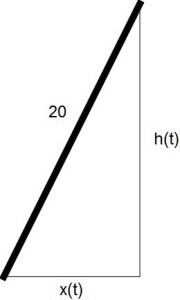I recently got to the part of my calculus class where I get to gleefully skip the section on related rates. I love skipping it. I get to feel like a real professor making real pedagogical decisions, and I earn some good will from the students who know what I just spared them from.
A related rate problem establishes two functions that depend on a single variable, usually time, where the functions are related by some governing equation. This equation is either explicitly given or is determined from the physics or the geometry of the problem. The rate at some time is given for one of the functions (i.e., you are given the derivative of one of the functions at a point). You are asked to find the rate of change of the other function at that time. This is possible by differentiating the governing formula implicitly.
Here is a standard one: The top of a 20-foot ladder is sliding down a wall at a rate of 2 feet per second. How fast is the bottom of the ladder moving away from the wall when the top is 16 feet from the floor?
Let h(t) be the height of the ladder at time t and let x(t) be its distance from the floor. We suppress the t since we are never going to need to find its value (an important conceptual obstacle for many students, I think, is where the t is in all of this). By the Pythagorean Theorem, $$x^2+h^2 = 400.$$ Since this is about rates, we differentiate implicitly to get 2xx’+2hh’=0, or xx’+hh’=0. We are interested in x’ when h=16. We are already told h’=-2 (assuming the negative direction is downward). That just leaves x, which our Pythagorean relation shows must be 12. So 2xx’+2hh’= 2(12)x’+(16)(-2)=0, or x’ = 4/3 feet per second.
Here are some reasons I don’t cover this.
The material is terminal. Nothing in a typical calculus sequence depends on related rates. That’s not a complaint — there are plenty of good terminal topics in calculus — but it means the topic is eligible for skipping since it won’t screw something up down the road.
It does not fit in the narrative. Every course is telling some kind of story. Related rates are that unneccessary expository character that a better writer wouldn’t need to introduce. Maybe there is a perception that related rates make calculus feel more useful, but if you are having trouble selling calculus as useful then you just aren’t trying. Related rates have a completely different feel from anything else in the course.
It is a fake application. I get that we need to connect the material to the real world, but these are contrivances. Related rate problems never feel like something anyone would actually need to solve. This is in contrast to something like optimization where well-chosen problems can leave students thinking they may actually need calculus again some day.
There are only a few kinds of problems. This is a section where the strategy of trying one of each kind of problem and mimicking the right one can actually work. There’s the Triangles problem (e.g. slipping ladders, relative positions of vehicles, and lampost shadows; usually the governing equation is the Pythagorean Theorem, but they may use trigonometric relations if angles get involved), the changing volume or area problem (e.g. expanding oil slicks, melting snowballs, and inflating balloons), and the generic “here, just use this formula” problem (e.g., assorted physical laws, or an incredibly silly one I just saw quantifying two people’s love for one another. Their love is a conservative quantity for some reason. I’m not optimistic for this relationship.) .
It depends on a topic most students already find difficult. The rates being related concern implicit functions of time. Students in calculus often have a tenuous grasp of functions generally and implicit functions are hard enough on their own before piling story problems on top of them.
Many problems depend on other content. Many related rate problems require applying geometric formulas like the volume or surface area of the sphere or various physical laws. So now you have to wonder if a student missed a problem because she can’t do the calculus or because she just couldn’t remember that formula. Or you give the formula in the problem and you have telegraphed most of the solution. It’s awkward.
It reinforces mistaking answer acquisition for problem solving. This is the deal-breaker for me. Students can often navigate this section without actually learning anything because they can get by on mimicking examples. Every calculus teacher — every mathematics teacher — is perpetually battling this idea that if you can get the right answer then you understand it. If I am rewarding you for getting answers that you cannot explain outside of the limited context of a particular problem then I am not doing my job.
I’m not really this anti-related rate. I can see some non-standard calculus courses where the topic flows quite naturally. But with all of the content pressures on the standard curriculum, related rates just don’t fit for me. That’s one more day I could be spending on the Fundamental Theorem of Calculus.
Bill Wood is an Assistant Professor of Mathematics at the University of Northern Iowa. He tweets as @MathProfBill.
